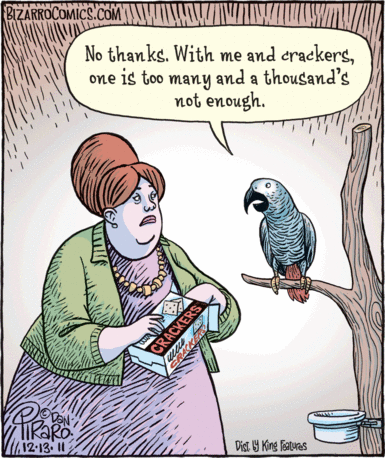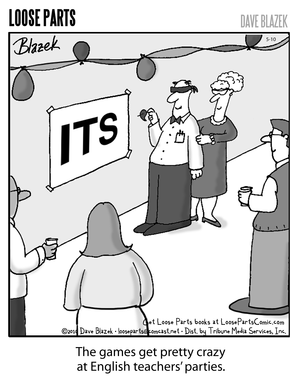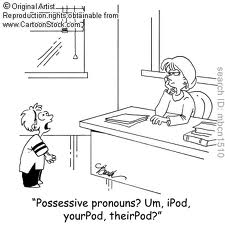When not to use whom
Most of the time when you run into a lesson about who and whom, it’s about using whom when you want to use who. I’ve even posted about it. (Search the site for “whom” for a few other examples.) Usually these articles compare the subject (who) with the direct object or object of a preposition (whom).
There’s another time to use “who,” but first a little background. In Indo-European and Semitic languages at least, the verb “to be” and its various forms and equivalents (seem, appear) are somewhat special. “To be” etc. is equivalent to an equals sign , and the name for this kind of verb is a copulative. Your grade school teacher probably called them linking verbs. Copulatives couple things together. That means that a noun at the end of a sentence that uses a copulative isn’t a direct object. It’s a predicate nominative.
For example:
Tom is a dentist. Tom and Dave are dentists. They are good dentists, and they are also my cousins.
If we use and equals sign in place of the verb, the meaning is the same:
Tom = dentist; Tom and Dave = dentists.
Predicate nominatives have the same case as the subject, even though they might be where you expect a direct object. It’s the verb’s fault. Copulatives take the nominative, we say. (“We” being linguists, grammarians, and now you, I hope.) So this guy approaches the pearly gates, and St. Peter asks who it is. “It is I,” says the man. Peter mutters to himself, “Ah, an English teacher.”
So be alert! Use “who” with linking verbs. Here’s an example of a professional writer (and his editor, apparently) in a Live Science article who wasn’t paying attention:
There’s no telling whom the original owner of the teeth and finger was, but the cave where they were discovered was both a hermitage, or dwelling place, and the site of a grisly medieval massacre. [8 Disturbing Archaeological Discoveries]
That “whom” really grates. It’s not only at the beginning, where you expect nominatives, but it’s with a linking verb, which takes the nominative.
So there you have it. Two times to use who, not whom. As subjects and with linking verbs.
Subscribe to this blog's RSS feed
The parrot is correct
Here’s a comic I ran into recently. The parrot got three things right that a lot of folks get wrong. Bizarro is generally pretty funny, by the way, and I recommend it.
 The first thing is he mentioned himself first. Yes, this is opposite of an aside I made in a recent post about case. Normally, out of humility, you’re supposed to mention yourself last, but it’s not necessary to put yourself behind inanimate objects, and he’s talking mainly about himself anyway.
The first thing is he mentioned himself first. Yes, this is opposite of an aside I made in a recent post about case. Normally, out of humility, you’re supposed to mention yourself last, but it’s not necessary to put yourself behind inanimate objects, and he’s talking mainly about himself anyway.
Second, he used the correct case. Many people would have said “With crackers and I…” and this is wrong. Object of a preposition—use “me.”
Third, a lot of folks would have missed the apostrophe in “a thousand’s.” It’s a contraction of “thousand is.”
Fourth, he didn’t point out that his mistress had eaten a few too many crackers herself.
Case part four
Last time I wrote that objective case is for direct objects and other things. Today we’ll look at one of those other things. Think of the objective case as appropriate for anything that’s not a subject and not possessive.
That means you use the objective case with prepositions, and that’s where many people mess up. And it’s your teacher’s fault! Remember you used to say, “Me and Tom are gonna go play in the park.” Your teacher would pounce on you, saying, “Tom and I are going to the park.” And you would endanger your life by saying “Oh! Do you wanna come to?”
We humans are pattern recognizers, and that pattern of putting someone or something else ahead of “I” became imprinted in our minds, so we used it all the time, even after prepositions. This produced sentences like ” The company finances were worked out between the company president and I.”
Sorry—”between” is a preposition. So are a large number of other words. Google “preposition” if you have any doubt what they are. (By the way, “like” is a preposition. The book title Black Like Me is correct.) After a preposition use me, us, him, her, or them. English doesn’t have a separate form for “you” except in the joke, when you act all high-falooting and say, “Whom are youm?” (To which you would get the reply, “I am me-em.”)
We don’t get it wrong when the pronoun is alone, so a good way to check if you have a sentence correct is to leave out the other person. Suppose your English teacher scolded you and Tom for getting your pronouns wrong. You would not say “He really gave it to I,” you’d say “He gave it to me.” So you know the sentence should be “He gave it to Tom and me.”
I mentioned in the first post about case that the only reason to mention the other guy first is that it’s more polite. If you name yourself first, though, you will use the correct case. It’s easy to say, “He really gave it to me and Tom for not being humble.” That isn’t humble, though, so don’t do it.
That’s it for grammatical case for a while. Fill out the form on the right for some more pointers on how to write well.
Case part three
Nominative case—subject of a sentence and predicate nominatives
Objective case—Direct object and other things
That leaves possessive. Not very many people have trouble with this one, except for possessive pronouns and plurals. We’ll get to those in a moment.
Did you ever wonder where the apostrophe came from? English is a Germanic language, and the possessive form in German ends in -es. You can see this form in Old English. As time passed, we dropped the e and replaced it with an apostrophe, same as with contractions. So our possessive nouns are really contractions.
Here’s the rule for making correct possessive nouns:
- Look at the word you want to make possessive, plural or not.
- Does it end in “s”? Then add an apostrophe and you’re done. For example, my first name is Rogers. This blog is mine, so you could say that The Writing Rag is Rogers’ blog. If you pronounce it “Rogerses,” you are correct.
- No “s” at the end? Then add apostrophe-s and you’re done. My evil twin is Roger. He does not own this blog, so this is not Roger’s blog. You would pronounce this “Rogers.”
Why couldn’t you add apostrophe-s to Rogers? You could, but then you have a problem with words like waitress. Three of the same letter in a row is forbidden in English. (Can you think of the exception to this rule?)
On to the pronouns. Here’s the rule: Memorize them! His hers its. Not an apostrophe in sight. They are their own form. They are not nouns—don’t do the apostrophe! Harrumpf!
Case part two
We use the subjective (nominative) case for two things in English—the subject of a sentence or clause, which everyone gets pretty much correct pretty much all the time. The other place for the nominative is in a construction called the predicate nominative. Remember that term? I’ll explain it later. First we need two items of background.
First, think about how basic sentences are constructed in English. One basic sentence goes Subject, Verb, Direct Object. In that order. Since English has dropped a lot of inflectional endings, the order is usually important. Tom saw Mike is different from Mike saw Tom. (Notice that both names have the same form in both places) A lot of languages put a syllable or so at the end of a word to indicate how it’s used in the sentence. In Greek, for example, we might have something equivalent to Tomos saw Mikeon and Mikeos saw Tomon. That -os and -on are inflectional endings. It’s handy, in a way, to have inflectional endings because if you write Mikeon Tomos saw, your reader would know who saw whom without needing the word order. In fact the Greeks played with word order a lot because they could, with all those inflectional endings, and they had a lot of them.
Direct objects aren’t in the nominative case; they ‘re in the objective case, even if English doesn’t use an inflection to say so. Hence the ‘whom’ in the previous paragraph. That -m on whom is an inflectional ending. Literally, if I had written “who saw who.” I could have been writing about someone looking at his reflection in the mirror. (You might object that the reader can figure it out from the context. True, but that violates one of the main tenets of good writng. I mention it in that freebie order form in the right margin of this blog, but if you ask me directly, I’ll just tell you.)
When you think about word order, a predicate adjective looks a lot like a direct object.
Now the second bit of background, the verb “to be.” This word, in every language I have any acquaintance with, breaks a lot of rules that apply to most verbs. For one thing, it’s always irregular. You have to learn the different forms; it doesn’t follow the patterns most other verbs follow. We say, for example, “I see, you see, he sees” but “I am, you are, he is.” No pattern. Another thing about “to be” is that it is equivalent to an equals sign, but almost every other verb is equivalent to doing something. When Tom sees, he is doing something. But when Tom is the boss, that means Tom=boss.
Since both ends of a sentence containing some form of “to be” are equivalent, we use the nominative. We would say Tomos is the bossos. The correct case is easier to remember in highly inflected languages. In English, where word order is so important, we get used to the pattern of having the objective case at the end of the sentence, so we tend use it all the time. “It’s me, Oh Lord, standin’ in the need of prayer” goes the song.
My Freshman English professor told this story:
St. Peter, at the pearly gates: Who’s there?
Person: “It is I.”
St. Peter: Ah, an English teacher!
So there you have it. Verbs of being take the nominative. Officially. I suppose it’s a losing battle, but at least now you know.
And I humbly beg the indulgence and forgiveness of you Greek scholars out there.


